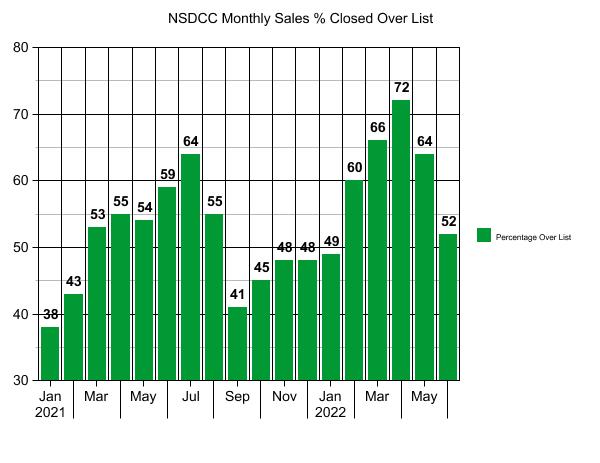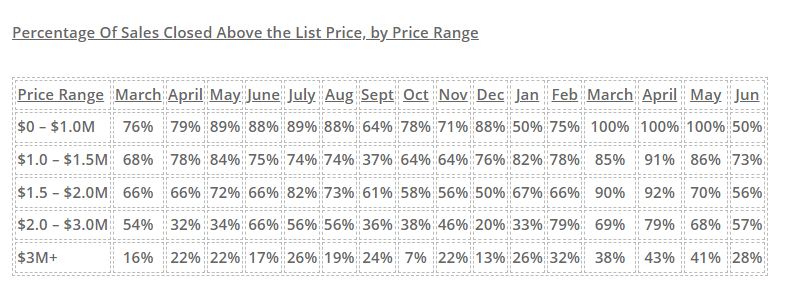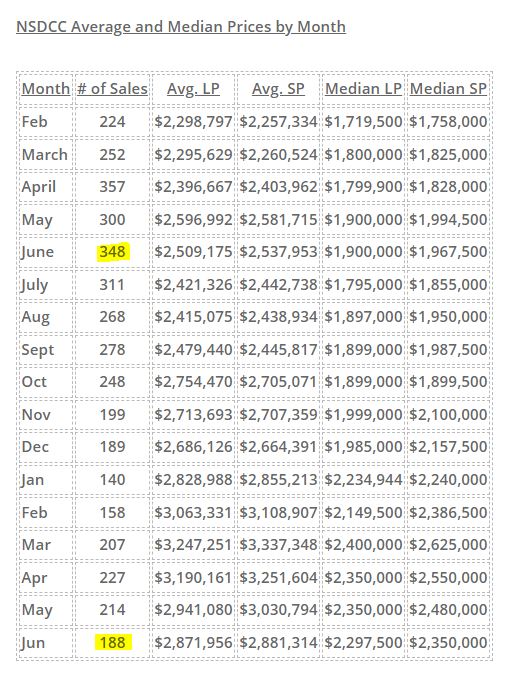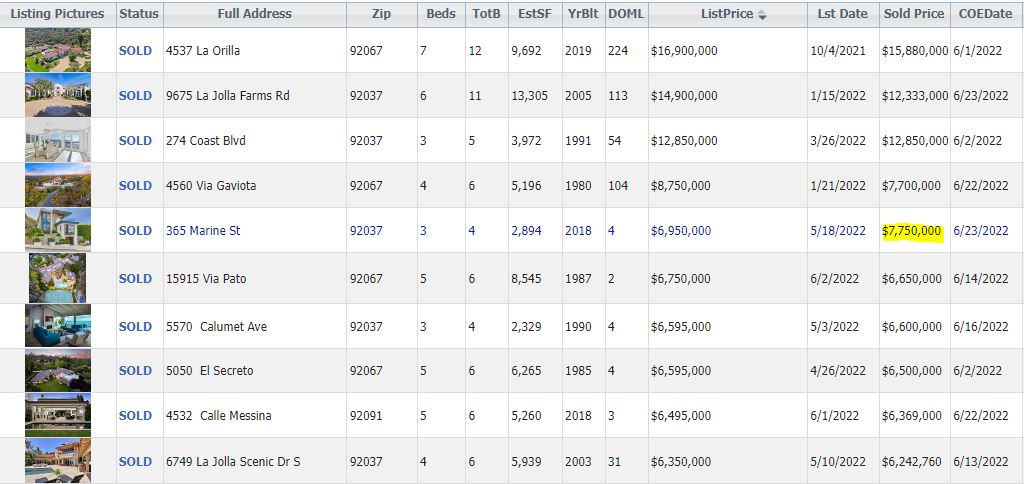
Paying over the list price must have some addictive qualities!
Either that, or the superior homes are still attracting a lot of attention. Well into the higher-rate environment, more than half of the June buyers paid over the list price!
Here is the breakdown by price range:

The average and median sales prices have been drifting downward, but both are still above the list prices:

The year-over-year sales are going to look terrible because 2021 was an incredible frenzy. The NSDCC June sales in the three previous years were 274, 282, and 299, so the 188 is only 34% below that average.
My La Jolla sale was the fifth-highest sales price in June, and sold for $1,150,000 more than the oceanfront house on Calumet. My $800,000 over list was #1 – it was the most over list of all the June sales!





When Steve Ballmer retired from Microsoft in 2014, his wife, Connie Snyder, informed him his next job would be to help run the family philanthropy, which fosters upward economic mobility among children from lower-income families.
“My initial reaction to my wife was, ‘That’s the role of the government. We have to pay our taxes, and government does the rest,’” Ballmer recalled in an interview at Yardbird, a fried chicken restaurant near Capitol Hill. “She said, ‘We’re working on this together.’ I said, ‘Fine.’”
The more Ballmer thought about it, the more he realized that not only did government have a large role to play in making Americans more prosperous, he didn’t feel like he had a good understanding of what government as a whole was trying to do with his tax dollars — where it was succeeding and where it was failing. He wondered: What kind of educational outcomes are we seeing? What kind of crime outcomes?
“I wanted to understand where we could make a difference,” said Ballmer, who was known at Microsoft as a voracious consumer of data and information. “I wanted to see the numbers.”
As a business executive, he could study the annual 10-K reports that all publicly traded companies must file with the Securities and Exchange Commission to find out what his competitors were up to. But there was nothing analogous for the American government, from the federal level on down. That, he discovered, was partly the result of our uniquely fragmented system, and partly because of sheer disorganization and bureaucratic dysfunction.
Ballmer found this frustrating. So he set out, as he put it, “to create a product I would want to use.”
In 2014, Ballmer created an early version of USAFacts, a website that set out to answer his own questions about the way American government works — and doesn’t work.
Eight years on, USAFacts is a nonprofit group that now produces an annual report on the state of the country, stuffed with slickly produced figures and charts on trends in living standards, firearm-related deaths, inflation’s effect on wage growth, states that are weathering the pandemic the best and much, much more.
Ballmer can rattle off many of the statistics from memory, and he apologizes when he briefly forgets a number. He also enjoys quizzing his audience on the data, at one point asking me: Do you know how many veterans there are in the United States?
When I demurred, he took pride in noting that the Department of Veterans Affairs estimates the number at 20 million, while the Census Bureau will say 18 million — a gap he called “crazy.”
“You have to put the pressure on the agencies,” he said. “They’re very professional, good statistical people. But nobody actually asked the Census Bureau and the Veterans Department to agree on the number of veterans in the country.”
Drawing on his days running the world’s largest software company, Ballmer also published a mock 10-K report for the fiscal year that ended in September 2019 — 250-odd pages detailing the revenues, expenditures and other “key metrics” intended to help Americans form their own conclusions about whether their tax dollars are being spent wisely.
Ballmer, a serial entrepreneur who also owns the Los Angeles Clippers, recently hired Poppy McDonald, the former president of Politico, and Amanda Cox, a past editor of The Upshot at The New York Times, to help build out his team.
When we spoke, Ballmer had just returned from a whirlwind day of briefings on Capitol Hill, where he met with the House Select Committee on Modernization and the Problem Solvers Caucus, as well as Representative Steny Hoyer, the No. 2 Democrat in the House, and Representative Kevin McCarthy, the chamber’s top Republican. He also sat down with Denice Ross, the chief data scientist in the White House Office of Science and Technology Policy.
On the Senate side, he briefed around 25 senators — all of them Democrats, despite his best efforts to assemble a bipartisan audience. He held a separate, one-on-one Zoom session with Senator Jon Ossoff, who had come down with a mild case of Covid-19, and came away impressed with the Georgia Democrat’s probing questions about America’s labor shortage, which Ballmer attributes in part to declining birthrates and lower rates of immigration.
Ballmer is fond of quoting James Madison, a founding father and one of the primary architects of the U.S. Constitution. Madison urged the nascent federal government to develop robust systems for collecting and maintaining data on the state of the nation.
In a private letter to a colleague, Madison once wrote: “A popular Government, without popular information, or the means of acquiring it, is but a Prologue to a Farce or a Tragedy; or, perhaps, both.”
If Ballmer ruled the world, he would require politicians to document their agreement on a common set of facts. That alone, he thinks, would work wonders.
“Every elected official should have to read some summary and sign and say, ‘Yes, this is the basis of which I believe.’”
Ballmer’s eyes light up, too, when I bring up the subject of basketball, another of his passions.
He sees many parallels between sports and government, though he balks a little at the link between basketball and Sabermetrics, a data-driven system of evaluating baseball players that was developed by Oakland Athletics manager Billy Beane. The system became the basis of “Moneyball,” the 2003 book and 2011 movie.
But Ballmer is a numbers guy, and one reason he likes to contrast the N.B.A. with Congress is that he believes performance in both cases should be measurable somehow.
“There’s accountability,” he said of the N.B.A. “Every 24 seconds, you get a scorecard. You either scored that basket or you didn’t score that basket.”
He tells the story of how the N.B.A. has hired a software company that placed cameras in every arena in the league. The system watches each game and analyzes things like which defensive plays or tactics work best against which players, categorizes the data and reports back to the coaches on what it has found.
“If only our own government had a similar learning mechanism,” he says, somewhat wistfully, before adding, “There’s no real customer for the data. There’s nobody who says, ‘I’m going to use numbers to make a decision.’”